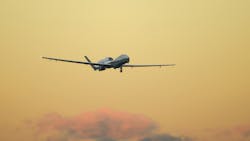The new Triton unmanned aircraft system (UAS) carries a suite of intelligence, surveillance, and reconnaissance (ISR) payloads to aid military commanders. It is tasked with gathering high-resolution imagery, detecting targets, and providing airborne communications and information-sharing capabilities. The U.S. Navy recently completed initial flight testing for the Triton, clearing it to fly at various altitudes, speeds, and weights.
At Northrop Grumman’s manufacturing facility in Palmdale, Calif., the test team validated more than 568 test points. It conducted 13 different flights totaling 81 hours at altitudes to 59,950 feet. Next, the aircraft will head to the Naval Air Station in Patuxent River, Md., where another test team will install and flight-test the Triton’s sensor suite. It also will validate the capabilities of each payload including the system’s primary sensor—a multifunction active sensor (MFAS) that provides the UAS with a 360-deg. view of ocean and coastal regions (see “Flight Tests Completed on Maritime Surveillance Sensor” on Microwaves & RF).
The Triton was built as part of the Navy’s Broad Area Maritime Surveillance (BAMS) program. It is based upon the Global Hawk UAS with added reinforcements to the airframe and wing. The de-icing and lightning protection systems also were enhanced. The current plan is to build 68 Tritons to be used with manned P-8 Poseidon maritime patrol aircrafts. Together, the systems will conduct continual intelligence, surveillance, and reconnaissance (ISR) missions across ocean and coastal regions.
About the Author
Iliza Sokol
Associate Digital Editor
Iliza joined the Penton Media group in 2013 after graduating from the Fashion Institute of Technology with a BS in Advertising and Marketing Communications. Prior to joining the staff, she worked at NYLON Magazine and a ghostwriting firm based in New York.
